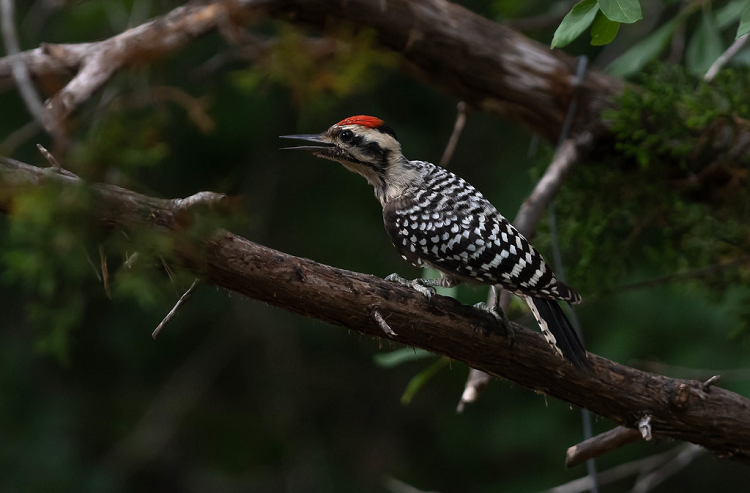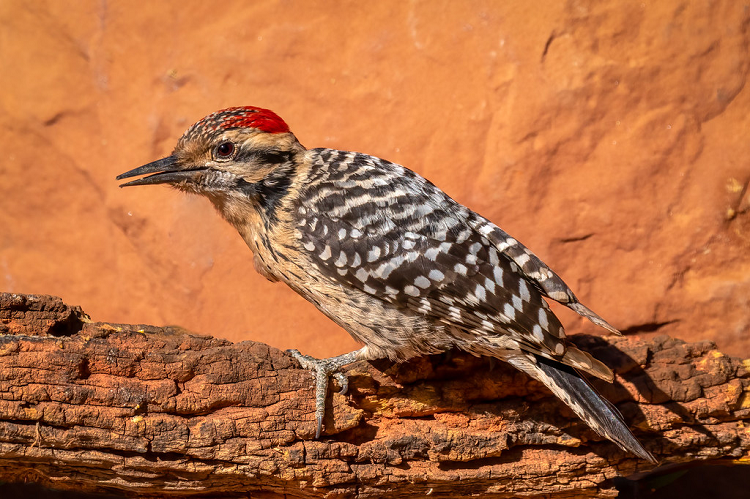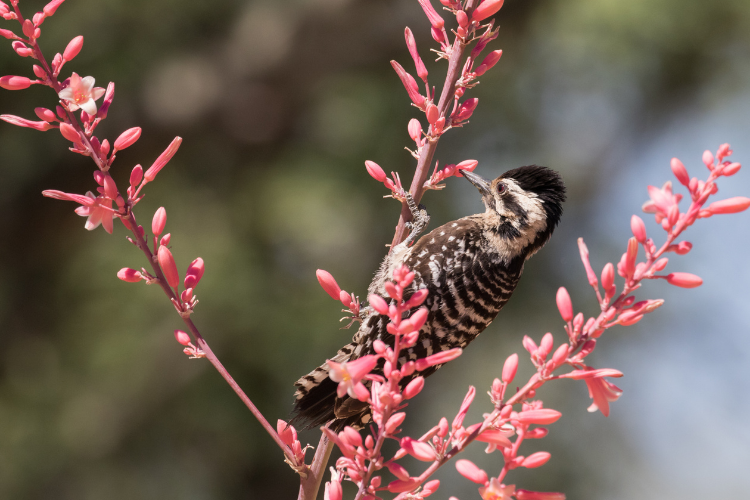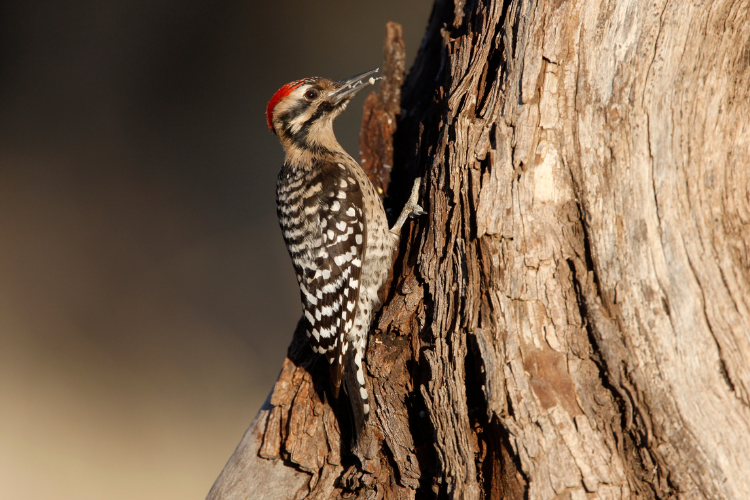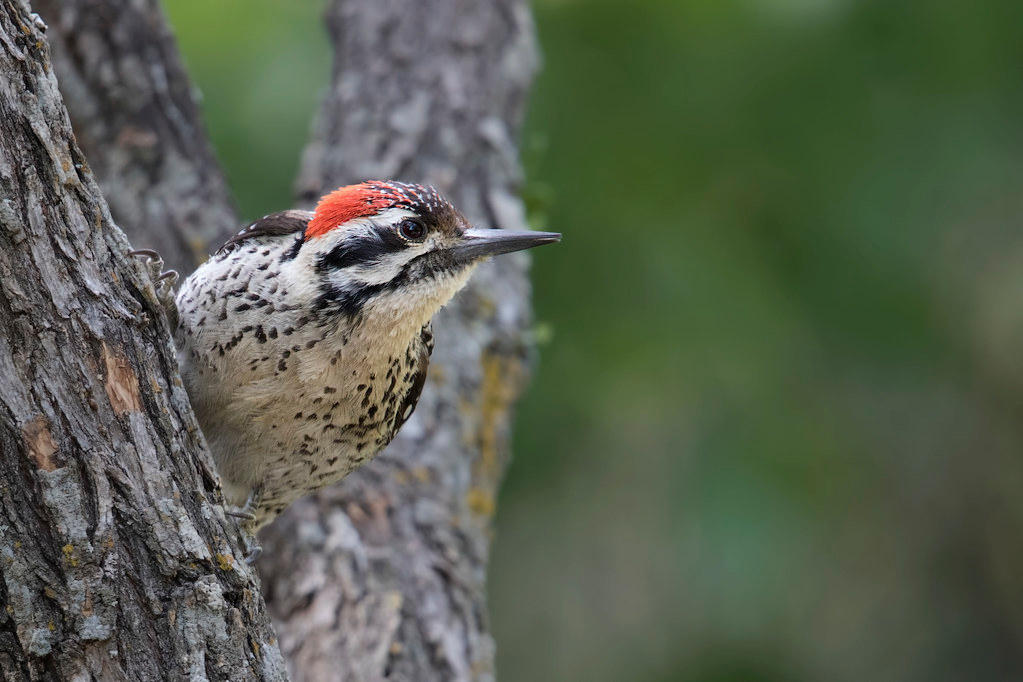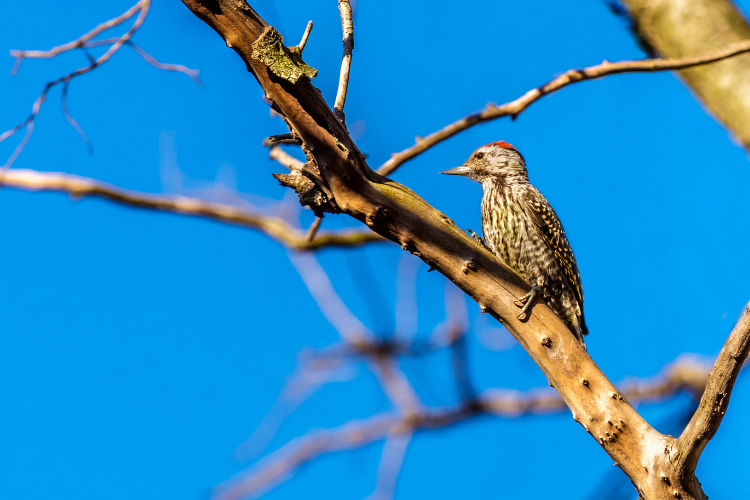- Amethyst-throated Mountain-Gem Guide (Lampornis amethystinus) - November 24, 2022
- Best Martin Bird House Guide - November 14, 2022
- Best Millet Bird Seed Guide - November 9, 2022
Whenever I hear that “tonk, tonk, tonk” sound, I break my neck looking up — in and around every single tree. I must find the woodpecker!
Whether you’re a lover of the sounds like me or are easily driven mad by the repetitive clunking, learning more about individual species of woodpeckers will improve your birdwatching game (it’s a thing) significantly.
I first became familiar with the Ladder-backed Woodpecker while spending time in southern Texas. To be honest, I was watching a Ladder-backed Woodpecker on a feeder at a bird blind, but I quickly became distracted by a Golden-fronted Woodpecker that interjected.
The colorful features of the Golden-fronted Woodpecker quickly dazzled me and stole my full concentration. I left the blind feeling a bit guilty for overlooking the Ladder-backed Woodpecker, so I devoted some time and attention to learning more about this cactus-dwelling bird. Now I’m here to share my notes and research with you!
Taxonomy
Woodpeckers belong to the family Picidae. This family also includes sapsuckers, piculets, and wrynecks. Their genus Dryobates means “woodland walker” and consists of the following species of woodpeckers:
- Ladder-backed Woodpecker
- Nuttall’s Woodpecker
- Downy Woodpecker
- Lesser Spotted Woodpecker
- Crimson-breasted Woodpecker
How to Identify a Ladder-backed Woodpecker
Most of the time, you know you’re looking at a woodpecker, but identifying the species can be difficult, especially when they’re standing on the side of a tree with only their back facing you.
All About Birds, an online resource by The Cornell Lab of Ornithology, shares four common identification keys that easily aid bird watchers of all levels. If you’re in a hurry for information about the Ladder-backed Woodpecker, this section will provide you with the most condensed knowledge about the species.
Size and Shape
Ladder-backed Woodpeckers are very similar in appearance to Nuttall’s Woodpeckers, so read closely! Ladder-backed Woodpeckers are small in size, reaching about 6 to 7 inches with an average wingspan of about 13 inches. They are larger than a Downy Woodpecker and smaller than a Hairy Woodpecker.
When it comes to the Ladder-backed Woodpecker’s distinguishing physical features, All About Birds describes a short neck, square head, and straight bill.
Color Pattern
Dryobates scalaris, or the Ladder-backed Woodpecker, is a sexually dimorphic species. This means that males and females are physically different. They display this by being dichromatic or having different colors. This is true for almost all woodpecker species.
Ladder-backed Woodpeckers are black and white, similar to most woodpeckers, and have a buffy white head with black face markings. These markings look like warpaint, covering the eyes, continuing through the bill, and meeting around the side of the neck like mutton chops.
Their backs have black and white barring that (at no surprise to anyone) look like a ladder. The wings continue this pattern, but it is slightly less synchronized and creates a checkerboard effect.
Their underparts are a white-gray color with black and white dalmatian-like speckles. Females have a black crown with a brownish-black spot between their eyes. Males have a red crown.
As mentioned above, the Ladder-backed Woodpecker is easily mistaken for other species in the same genus, such as the Downy Woodpecker and Nuttall’s Woodpecker.
The Downy Woodpecker does not have a barred back, which made things more straightforward, but differences between a Ladder-backed and a Nuttall’s were harder to differentiate.
To tell them apart, I think of the male’s red crown as a hairstyle:
- Nuttall’s Woodpecker: The red crown starts further back on the head and looks like a mullet, extending to the upper back/lower neck region. Black barring stops at the upper back.
- Ladder-back Woodpecker: The red crown begins at the eye, extends to the back of the head, and looks like a toupee. Black barring goes up the back.
Behavior
Knowing a bird’s mannerisms isn’t always necessary to identify them, but it does make things a whole lot easier and more enjoyable too!
The Ladder-backed Woodpecker hops in a straightforward motion. Whether on the ground or a tree trunk or branch, they don’t appear to be moving much other than their feet. When observing a Ladder-backed Woodpecker, try to look closely at its toes and feet. They have four zygodactyl toes.
This means that two face forward while two face backwards. This allows for optimal climbing, perching, and scaling of large trees, branches, and fence posts.
If you’re hoping to attract a Ladder-backed Woodpecker to your yard, be sure to supply a feeder that has an adequate tail prop. Like other species of woodpeckers, the Ladder-backed prefers to use its stiff tail like a kickstand on a bicycle.
This gives them stability while they feed on insects in trees, on plants, or at a bird feeder. Keep scrolling a few paragraphs for more tips on attracting these beauties to your yard!
The Ladder-backed Woodpecker not only looks like Nuttall’s Woodpecker but in areas where their breeding ranges overlap, males of the two species frequently squabble. To observe this behavior, look for head bobbing, bill pointing, wing spreading, and flying in a fluttering motion within close proximity to one another.
Additionally, listen for a high-pitched “peek, peek, peek.” This can sometimes be followed by sputtering.
Where Does a Ladder-backed Woodpecker Live: Habitat
Ladder-backed Woodpeckers live in dry scrubby desert climates throughout the southwestern United States and into Central America. They enjoy desert woodlands year-round.
Their top pick of habitats will have agave, yucca, Joshua tree, mesquite shrubs, walkingstick cactus, pinyon-junipers, cottonwood, and pine-oak woods.
Within the United States, You can find the Ladder-backed Woodpecker in southeastern Colorado, southeastern California, New Mexico, Arizona, and Texas. Keep heading south, and you’ll continue to see this bird until northeastern Nicaragua.
This species’ love of dry climates differentiates it from Nuttall’s Woodpecker’s desire to be near a river. While this is a non-migratory bird, they sometimes wander between areas but stay relatively close to the same region.
Ladder-backed Woodpecker Diet and Feeding
Did you know that some woodpeckers don’t peck at trees for food? Smaller species with shorter bills, like the Downy Woodpecker and Hairy Woodpecker, clean up after larger species that may have left a few delicious insects and larvae during their drilling.
The Ladder-backed Woodpecker enlists a few tactics when it comes to hunting, and drilling with their bill is one of them. Other hunting methods this species utilizes are probing and gleaning. If you’re like, “what the heck is probing and gleaning?” don’t worry, I’ve got you:
- Probing is the act of inserting the bill into the ground, cracks, under bark, or into trees and flowers.
- Gleaning is when a bird captures invertebrates by plucking them from the surface of trees, rocks, plants, and sometimes other animals.
A Ladder-backed Woodpecker’s diet is composed of many delicious insects. Ants, larvae, beetles, and caterpillars are the primary delicacies. However, the Ladder-backed Woodpecker will not stick up their bills to berries and cactus fruits when available. Their prey is sourced by foraging, gleaning, drumming, or probing.
Typically, male and female mates forage together, but in different areas. Yay teamwork! They will scale, hop, and walk along tree trunks, limbs, cacti, and bushes, scanning them for worthy prey.
The male focuses his efforts on tree trunks and large limbs, while the female tackles twigs, cacti, and shrubs. When the pickings are slim, they will head to the ground to continue the hunt.
Ladder-backed Woodpecker Breeding
Little is known about the intricacies of this species’ mating behavior. While mates stay together for the better part of a year, it is unknown how they determine a suitable mate or whether there is any performance from the male.
Woodpeckers are generally monogamous, but polygamous species such as the Acron Woodpecker do exist.
The Ladder-backed Woodpecker does not migrate during the breeding season or at all! They are residents year-round of the areas they inhabit. Breeding season for the Ladder-backed Woodpecker begins in late January through June.
Ladder-backed Woodpecker Nesting
The division of labor when it comes to building the nest isn’t very equal for the Ladder-backed species. The responsibility to excavate a nesting cavity in a tree falls on the males, but some observers of the species say that the female pitches in where she can.
After all, she is the one doing the egg-laying, am I right? Suitable tree species for nesting cavities include Joshua, mesquite, willow, oak, or hackberry. More creative nesting real estate includes dead limbs, agave stalks, giant cacti, fence posts, and utility poles.
A cavity is located at least 4 feet from the ground and sometimes as high as 30 feet, depending on the tree type. The cavity will have an opening of about 1.5 inches and is surprisingly deep at 7 to 14 inches.
The nest-building effort is focused on creating and clearing out the cavity, and that’s usually the extent of it. At 7 to 14 inches deep, I can’t really blame them for not wanting to build another nest inside.
Ladder-backed Woodpecker Eggs
The female Ladder-backed Woodpecker will lay a clutch of 2 to 7 eggs, with 3 to 4 being most common. Eggs are oval, white, and have no markings. They are generally less than an inch in width and length.
Eggs are incubated for a period of 13 days by the female and male. Once hatched, the nestlings are altricial, and both parents take on the responsibility of feeding their young. Typically only one brood is produced per breeding season.
Ladder-backed Woodpecker Population
Population numbers were most significant between 1966 and 2015, according to All About Birds. Today, the species is listed as Least Concern by the International Union for Conservation of Nature. According to the Partners in Flight Conservation Database, the current population size is estimated to be about 5.9 million.
Is Ladder-backed Woodpecker Endangered?
The Ladder-backed Woodpecker is not threatened or endangered at this time. However, U.S. Fish and Wildlife list the species as a conservation concern for the Edwards Plateau Bird Conservation Region.
Ecosystem Contributions
Every living thing plays a part, so how does the Ladder-backed Woodpecker play theirs? Their insect-heavy diet curbs a population that may otherwise take over healthy trees. Boring beetles create deep tunnels into stems, branches, and roots to lay their eggs.
This causes stress to the tree, and it will inevitably become sick or weakened. Thanks for doing your part, woodpeckers!
Attracting Ladder-backed Woodpecker
When attempting to attract certain species to your backyard, be sure you meet the qualifications necessary to sustain them with ample food and a safe environment.
For example, do you have an insect-friendly and pesticide-free yard? Do your cats go outside? Look around and consider other factors that might be unique to your area.
If your yard is free and clear of pesticides and cats, here are a few tips to lure the Ladder-backed Woodpecker in for a visit.
- Supply this bird with a mealworm or insect-heavy bird seed in feeders. Seed mixtures with sunflower seeds, suet, and tree nuts are also a plus. Keep feeders full year-round. I know this is a full-time job, and I see you bird people! Bonus tip: try rubbing some peanut butter on the feeder.
- Ensure your bird feeder is woodpecker friendly. This means the feeder needs to have a tail prop. Tail props allow the woodpecker to use their tail as a stabilizer and make their feeding sessions much more enjoyable.
- Assuming they are not a safety risk to your home or your family, keep dead trees in your yard. This is a great way to support many species of woodpeckers, chickadees, and owls.
- Consider adding a natural-looking bird bath or fountain low to the ground. Woodpeckers enjoy a bath just like many birds, but they prefer a more private experience where other birds will not spot them.
- Add a birdhouse fit for woodpeckers! A birdhouse is a score in the eyes of a woodpecker, and I can see why. Who wouldn’t love a perfect nesting cavity without having to do any of the work? The entrance hole should be no larger than 1.5 inches, and the birdhouse should be about 9 to 15 inches deep. Mount it 10 to 20 feet off the ground and wait patiently for your new tenants to scope it out. Be sure to keep the birdhouse clean between seasons and replace any nesting materials, such as woodchips.
Ladder-backed Woodpecker Predators
Bad guys are inevitable, and nature has a few. Ladder-backed Woodpeckers need to watch their backs for snakes, hawks, and owls. These miscreants (just kidding, they’re only trying to survive like the rest of us) are known to raid nests, eat eggs and hatchlings, and predate on adults.
Ladder-backed Woodpecker Lifespan
Ladder-backed Woodpeckers live a lot of life in a short period of time. They have an average lifespan of about 4.5 years. All About Birds tells us that this was the age of the oldest documented Ladder-backed Woodpecker, a male that was caught, banded, and released in Texas.
FAQs
Answer: Ladder-backed Woodpeckers are not necessarily rare. They are just located in particular regions of North and Central America. If you live on the east coast of the United States, you’re probably never going to see one.
But within just a few days in the dry brushy climate of the southwestern United States, I was lucky enough to spot one. After seeing my first one, it felt like they were everywhere.
Answer: Interestingly enough, Ladder-backed Woodpeckers prefer dry climates like the desert and pinyon-juniper woodlands.
These birds have overcome the hurdles of living somewhere with limited resources and can be found across southwestern North America to Nicaragua. They are non-migratory and inhabit the same region their entire lives.
Answer: Ladder-backed Woodpeckers hunt and forage for a variety of insects such as beetles, ants, leafworms, larvae, and caterpillars. Their prey is excavated from a tree, gleaned off of plants, or plucked off of cacti. When available, they will feed on berries and cactus fruits.
Answer: A high-pitched “peek, peek, peek” is sometimes followed by descending whinny.
Research Citations:
- Arnold, K. (n.d.). LADDER-BACKED WOODPECKER | The Texas Breeding Bird Atlas. Retrieved July 8, 2022, from txtbba.tamu.edu website: https://txtbba.tamu.edu/species-accounts/ladder-backed-woodpecker/
- The Cornell Lab of Ornithology. (n.d.). Ladder-backed Woodpecker. Retrieved July 8, 2022, from www.allaboutbirds.org website: https://www.allaboutbirds.org/guide/Ladder-backed_Woodpecker/overview
- Ladder-backed Woodpecker. (2022, January 25). Retrieved July 8, 2022, from BirdInformer.com website: https://www.birdinformer.com/ladder-backed-woodpecker/
- Sibley, D. (2016, February 16). A new clue for identifying Downy and Hairy Woodpeckers – Sibley Guides. Retrieved July 8, 2022, from Sibleyguides.com website: https://www.sibleyguides.com/2011/02/a-new-clue-for-identifying-downy-and-hairy-woodpeckers/
Looking for more interesting readings? Check out:


